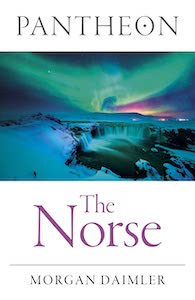
Pantheon – The Norse, by Morgan Daimler
Moon Books, 9781789041415, 152 pages, May 2022
Full disclosure: I am completely biased when it comes to Morgan Daimler. I adore her work and her no-nonsense approach to researching and writing, so much so that I end up adding her books to my already crowded bookshelves. Her latest offering, Pantheon – The Norse, is a welcome addition to my ever-expanding collection and is easily one of the best I’ve read on the subject.
Having already written two additional books in this series titled Pagan Portals – Odin and Pagan Portals -Thor, Daimler is well positioned to provide an introduction to the remainder in this latest offering, Pantheon – The Norse. The table of contents provides the reader with the information they need to determine where they will start in this book, as there is so much to choose from. Personally, I start with the Introduction.
The introduction sets the tone of the book, giving the reader the opportunity to familiarize themselves with the type of tone and language they are going to experience through Daimler’s writing. Straight forward, to the point, and without a lot of extraneous words, the introduction is the perfect set up for what the reader can expect from the rest of the book. For me, as well as many others, this is an opportunity to get a sense of who the writer is as a craftsman and what their style of writing is.
Daimler separates the book into two parts, each part playing a role in presenting the information to the reader. She explains:
“In Part I we will be looking at the history, beliefs, and practices of Heathenry and in Part II we will explore who the Norse Gods are as well as related spirits that play an important role in the belief system. These parts are divided fairly equally in this book, as I feel that it is important to both have some basis in the beliefs as well as a solid source for information on the deities and spirits.”1
Additionally, Daimler is clear about what the book is not, and explains that her goal with the book is “not to create an in-depth, one stop resource for the subject but to offer readers a wide range of basic information to give a better understanding of the subject or help beginners seeking a starting place.”2
Being a solid source of information is something Daimler does best, as she clearly shares what she’s gleaned from her own substantial research. Honestly, reading her work is so refreshing as there is no guesswork or need to double check what she presents. While the book is a great entry into this world, it’s written in an elevated way to ensure that even the most learned person on the subject can come away with at least one golden nugget of information they didn’t have prior.
Daimler provides enough information to get you through the sections without causing too much overload. Her writing style is clear and loaded with clues that point to other paths within the topic being discussed; should you feel called to explore further there are useful endnotes included depending on how deep you want to go within the history and mythology. For many readers, the knowledge provided is enough to give the reader a sense of the overall system and while some might feel like exploring, there is no sense of pressure to do so.
The chapters are clearly laid out and sequenced nicely, with one topic naturally flowing in the next. Providing bite-sized chunks of data within the context of the overall idea of the chapter is something that not all writers are able to do with such ease. There is enough info provided to give the reader something to chew on before the next idea is presented. That is something that I look for in this type of book. Don’t just spoon feed me a few bits of trivia; make the subchapters relate back to the main idea of the chapter but also make sure they are entwined in some way. That’s storytelling within the parameters of imparting knowledge and Daimler is a master.
There are many similarities and parallels between this pantheon and others most readily seen in the section called “Celebrations and Prayers”. Many of the celebrations observed in the Norse pantheon are also part of other traditions, albeit under different names. The commonality inherent in these old “religions”, through the use of similar names, dates, and themes of the celebration, makes it easier to understand as a reader if a similar spiritual path is being followed.
I love this book for the simple reason that it has all the elements I look for when exploring different paths: beautifully presented research in bite-sized chunks that are easily understood, a robust resource section, and so much more. I didn’t even get into the sections on Gods and Goddesses, which is one of my favorite sections.
Pantheon – The Norse is perfect for those who are interested in a ground level introduction to the Norse pantheon without all the fluff. Yes, there is a lot of information to digest and sure, there might be some ideas or concepts that don’t quite make sense for a variety of reasons. That does not take away from the parts of the book that will resonate with those wanting a deeper understanding of this pantheon. As with most books in this vein, take what you like and leave the rest.

Sarrah October Young is a writer and practising witch who wished she could do stand-up comedy. When she isn’t writing or witching, she can be found posting about her cats on IG @therealoctober.
